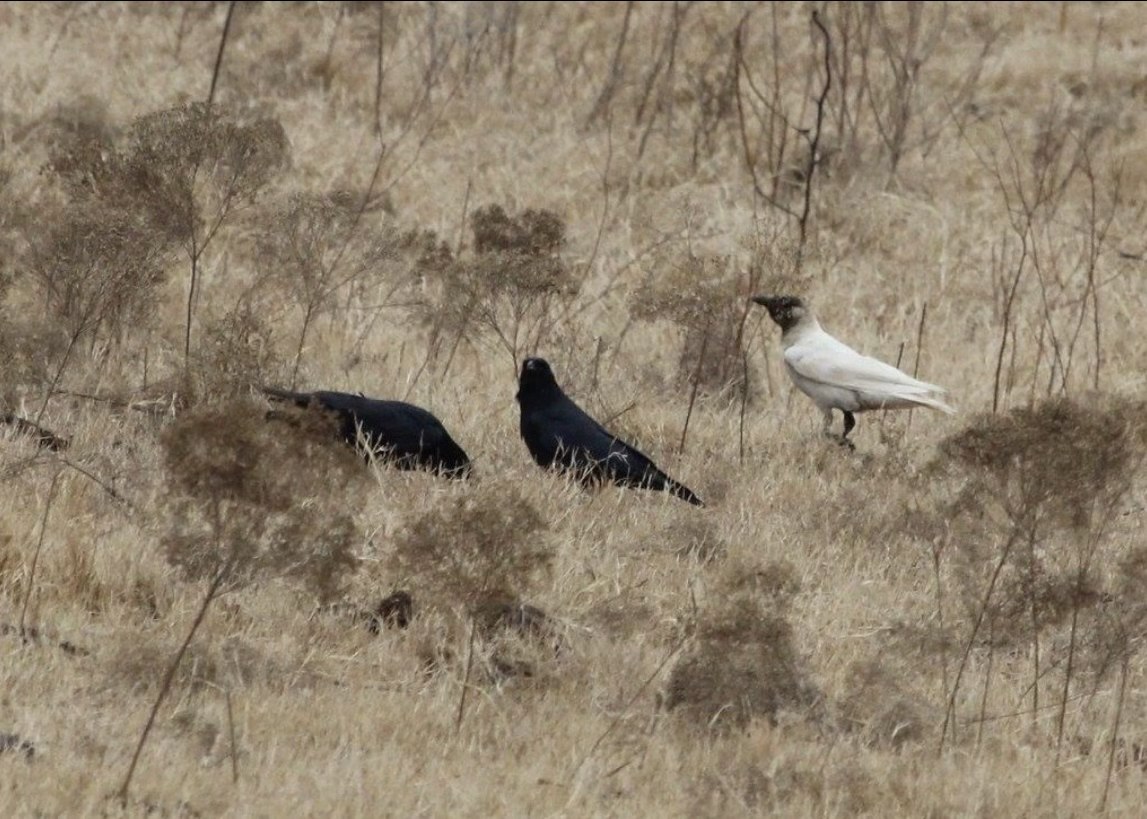Albino Birds
Contact
University of Arkansas System Division of Agriculture
Cooperative Extension Service
2301 S. University Ave.
Little Rock, AR 72204

Albino Birds
A couple of years ago, returning home from a long road trip, an albino redtail hawk flashed across the road in front of us. Getting a photo was impossible, but my brother Karl later shared a photo of a mostly albino crow with me. Albinism is rare. I read that it happens once in about 30,000 times with crows, but I doubt anyone has really counted. In humans it is likewise rare, happening about once in 18,000 to 20,000 births.
Albinism can be caused in several ways. At the feather level it occurs when a color pigment called melanin is not produced. Melanins are universal pigments found everywhere in nature including birds, bats, humans, mushrooms and sunflowers. Melanin in plants occurs as a stable, insoluble black or brown pigment and is usually associated with the seed coat. It is believed that the dark pigmentation found in many plant species helps the seeds blend in with the soil once seeds are dispersed.
Birds take advantage of melanin’s unique properties in more ways than the rest of the animal world and produce the full spectrum of colors seen in bird plumage. In some species, such as goldfinches, melanin helps them blend in with the deciduous woodlands in winter. But come spring, new plumage and mating season, the bright yellow feathers help sell the wares of the males to the ladies in the flock. If melanin is not produced at all, the resultant animal will be an albino with white feathers and tell-tale pinkish eyes.
Failure to produce melanin can be due to a specific mutation, expression of melanin-controlling genes, or even injury during development of an embryo. A specific mutation will cause a single individual to express albino characteristics and, in most cases that mutation will not make its way into the genome of the species. This type of change, and albinism caused by injury during development, are one-and-done events.
Production of albinism via the gene expression route is probably the most common cause of wild albino birds, but it is still rare. Albino traits are recessive and only occur when both parents are carrying the gene for albinism but in a masked (heterozygous) form. If the production of melanin is controlled by a single set of genes – an unlikely event – then offspring of such a union would have a one in four chance of showing albino characteristics. If more than one gene is involved, and if the expression of the gene depends on the presence or absence of specific control genes in the genome, then the likelihood of an albino offspring being born becomes very unlikely.
Albinism is a detriment to survival and relatively few albino birds reach maturity and enter the breeding pool. Melanin protects feathers from sun damage, so all-white birds are thought to expend more energy in flight than normally colored birds. The red, unprotected eyes mean their eyesight is impaired so they have more trouble finding food. And – being different – albinos are usually less successful in finding a mate.
White birds are more likely to suffer predation than their darker, often camouflaged kin. The ancestors of the modern chicken arose in the forests of south Asia and were beautifully camouflaged to hide amongst the foliage. Albino birds in such a dark forest would have stood out like beacons in the night.
The white broiler chickens produced by the millions in Arkansas are not albinos, though the white feather characteristic may have originated that way in the far distant past. The prototype for modern broilers and laying hens relied heavily on the White Leghorn breed which originated more than 150 years ago. In this breed, white feather color is dominant, but the eyes, comb and feet have normal pigment development. Other breeds have white mutants that are based on a recessive model of inheritance. The poultry industry favors white plumage color because the carcasses of white-feathered birds are cleaner to the eye than breeds with darker down.
